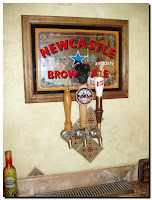In the mean time, here's my review of another three beers I've recently tasted.

Micro cerveceria La Chingoneria's Amargator is labeled as a imperial India pale ale and claims to come in with 100 IBU's This beer is a beautifully balanced, malty beer that if I hadn't read the label would have considered it a barley wine. A big, full malty beverage with enough bitterness to cut the caramel sweetness. The hop aroma and flavor are subdued with the caramel qualities taking the spotlight. This is a big beer at 9% abv. and although La Chinganeria claims to add avocado leaves in the boil, I didn't get any of that flavor. This is not a bottle conditioned beer and is brewed in Mexico city. There website doesn't give much information and is basically there to direct you to their Facebook page. I wrote to the brewery asking about the nomenclature and they assured me that this is indeed a IIPA, I didn't argue.

The Baja Blonde, brewed by the Baja Brewing Company is another Mexican beer that comes across sweet before anything else. I'm beginning to believe that the craft beer brewers in Mexico are trying to stay close to the bitterness level of Modelo (the beer most are used to drinking) in order to entice the consumer slowly away from the big boys. Calling itself a cream ale, this beer is sweet, with sweet honey flavors and a lot of sweet fruitiness. The hops are barely detectable as a citrus quality. At 6% abv. this beer is clear, dark straw in color and filtered. This brewery brew/pub is owned and operated by gringos from Colorado, so they should have the reference point of the Colorado beer scene to produce beers I like. I'll be trying the other labels they have to offer in the near future like their Black, Red, and Stout, to see if this is true.

Finally, a 4.5% pilsener that again is on the sweet side is Rio Bravo which is brewed by Cerveceria Mexicana also known as Mexicali produced in Tecate, Baja California. They also brew a beer called Red Pig which I'll review in a future post. It's a little confusing for me which is which regarding the brewery. I haven't figured out if Mexicali produces Cerveceria Mexicana or the other way around. Regardless, Rio Bravo is a sweet bready beer with light caramel notes and no hop fragrance. It's full bodied and has a long lasting white head. An easy drinking beer that's enjoyable on a hot day. Bottle conditioned.













































